Neurobiology of Trauma
and Treatment |
James
Kowal, M.S., LCPC |
| 5. MULTIPLE TRAUMA AND
RESULTING BELIEF SYSTEMS |
|
|
|
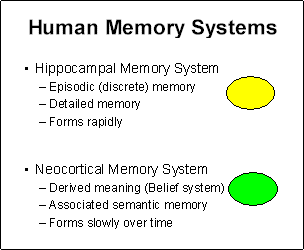 |
The
neurobiology described to this point has focused on the Hippocampal
Memory System and its role in trauma. This is the memory system in which
discrete events are recorded. It is also known as the episodic memory system and holds the
many details that are recorded rapidly while experiencing the event.
Also in the human nervous system is the Neocortical Memory System. It is where beliefs are stored. When trauma has occurred repeatedly, the
person’s belief structure is affected. |
|
|
|
The belief structures of
the Neocortical Memory System form slowly over time. Also described as "associated
semantic memories," these deep belief structures are relatively difficult to change. |
|
When
someone is experiencing a "normal" life event, all the signals from the senses
come into the thalamus. The thalamus sends information about the event to the prefrontal
cortex, where memory is searched for similar experiences and feelings. This information is
then sent to the amygdala. The amygdala compares the information from the thalamus and
prefrontal cortex and determines the significance of what is happening.
This evaluation of the level of
significance (in terms of the probability of danger) is sent to the hippocampus. The
hippocampus also receives information from the thalamus about the current experience. |
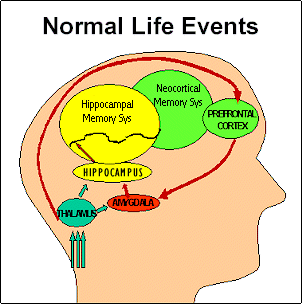
|
|
|
Based on these two sets of
information, the hippocampus determines where in the Hippocampal Memory System to route
and store the memory. In the slide, the memory trace is represented by a jagged line,
indicating some minor changes in affect while the information is being stored.
Studies of REM sleep and memory, conducted by Harvard sleep researcher Robert Stickgold
(1998), help reveal the role of the Neocortical Memory System. |
|
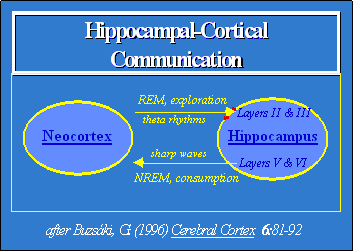 |
During REM
sleep, the Hippocampal Memory System (HMS) engages in an active conversation with the
Neocortical Memory System (NMS). As energy passes through the neuropaths of the detailed
memories stored in the HMS, information is transferred to the NMS, where the belief system
resides. This exchange of information continues through the night in 90 minutes sleep
cycles. |
|
|
The REM sleep segment of
the cycle increases in length as the night progresses.
|
It is during the
REM "conversations" between the HMS and NMS that many of the discontinuities in
the HMS are resolved. The information in the neocortex is arranged in what is often
referred to as a schema, an organizational structure of how we understand ourselves and
our world. Information from the HMS finds appropriate places in the NMS’s schemas,
and we come to a new understanding of what we experienced the previous day. |
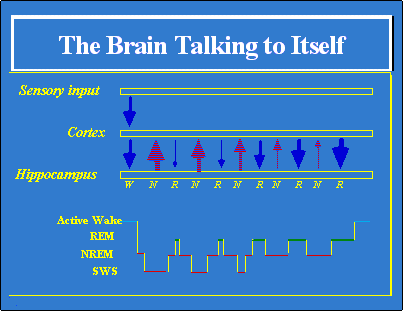
|
|
|
|
|
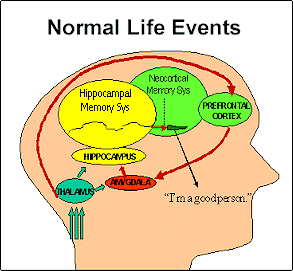 |
When most
people have a memory of a normal life event, the memory (stored in the HMS) is usually
linked to a positive belief about oneself (stored in
the NMS). Even if the memory is about an event that has a negative impact on the person,
the person can still believe something along the lines of, "I did the best I
could," or "I deserved to be loved," or "I’m still a good
person." |
|
|
When the
memory path contains a complete memory trace of an incident (no discontinuity or
"hurt spot"), the energy flows through the detailed memories of the HMS and
links to the positive belief about the self in the NMS. As time goes on, the HMS pathway
begins to weaken and the memory fades. But the NMS portion, which is also influenced by
other experiences, may continue to grow stronger, reinforcing the positive
self-evaluation. Even if the detailed memory in the HMS is eventually forgotten, the
belief derived from the experience remains. |
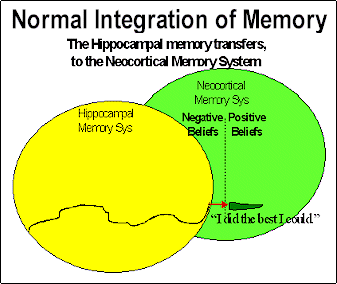
|
|
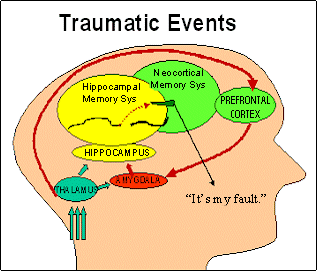 |
When, on
the other hand, a person experiences trauma and there is a
break
in the continuity of the memory, the partial memory segment of the event seems to link to
a negative belief about oneself. Even if the person
was not responsible for the negative outcome, or was an innocent victim of some kind, the
person tends to believe, "It was my fault," or "I don’t deserve
better," or "I’m a bad person." |
|
|
|
It is
almost as if the NMS has a negative belief section and a positive belief section about the
self. Incomplete memory paths of traumatic incidents seem to always relate to negative
cognitions about the self. Thus, the people remember a part of the incident and feel
terrible about it, even if there was nothing they could have done to prevent it or protect
themselves. The event is linked to the negative schema about oneself, and the person
believes it is evidence of the negative belief, even if the negative belief is irrational.
|
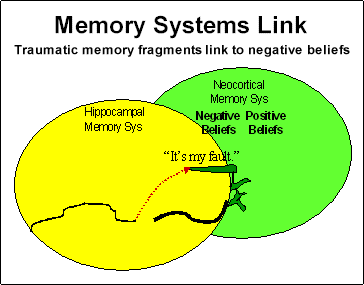 |
|
|
Broken
links are attracted to the negative schema, unbroken links to the positive. If through
time, REM sleep, or psychotherapy, the memory segments of the traumatic experiences are
linked together in the HMS, energy begins to flow completely through the neuropath and
links are established to the positive schema in the
NMS. |
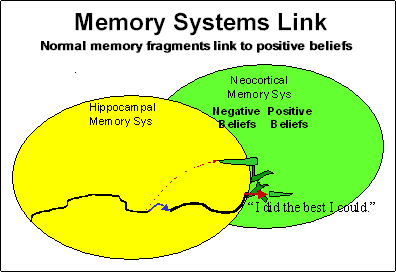 |
|
|
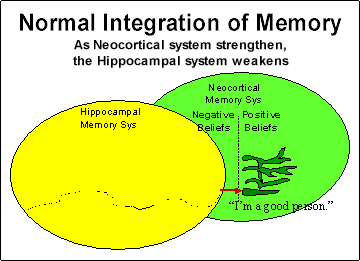 |
Ideally,
the links to the negative schema dissipate, the negative belief fades, and the positive
belief, such as "I am a good person" or "it wasn’t my fault,"
grows stronger. |
|
|
|
|
|
|
 |
 |
|
 |
 |
|
|